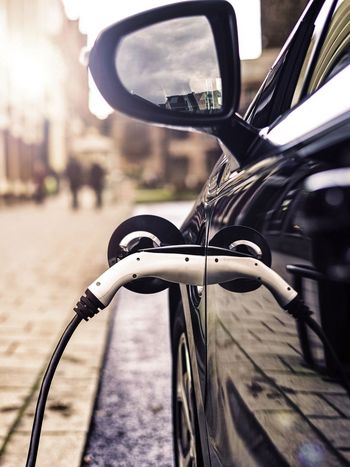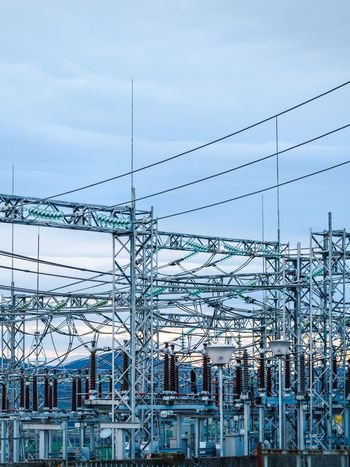African Energy Future between Local Microgrids and Global Interconnections: CIGRE has an active role to Play
Africa traditionally presents an energy paradox: endowed with abundant natural resources (minerals, energy, forests, sweet water) but very scarce electricity supply for people and power shortages for industries; this is due to many reasons, both historical and socio economical. Some of the megatrends characterising the ongoing energy transition can be particularly beneficial for Africa, namely: dominant deployment of cheap and efficient renewable sources (RES), effective micro-grids in rural areas, large interconnections (both domestic and intercontinental) as part of the global grid concept, customer-oriented digitalization.


Chairman CIGRE Study Committee C1
So, this is a high time for Africa to leapfrog from the conventional solutions to the most modern and cost-effective ones, thus shaping a sustainable development trajectory for itself. Africa’s hydro, wind, and solar account for, respectively, 12%, 32% and 40% [1] of world’s resources, and these can thus substitute the present extensive use of basic biomass (wood) and fossils. CIGRE can play a relevant role, spreading technical knowledge, exchanging professional experiences, and fostering capacity building for the next generation of young African engineers.
As it can be seen from the night spatial view and social statistics in Fig.1, Sub-Saharan Africa (i.e., excluding countries on Mediterranean shore and the Southern tip of the Continent) presents a homogeneous pattern of economic underdevelopment, low income, and energy/water/health poverty. It also clear that these issues are highly interdependent (energy-water-health nexus). Out of the 900 million people worldwide without access to electricity (and/or to basic clean cooking facilities), 640 million are in Africa, corresponding to an access rate of 40 percent in Sub-Saharan Africa; per capita yearly consumption is 180 kWh, compared to 6,500 kWh in Europe and 13,000 kWh in the US.


Drinking water, sanitation and hygiene
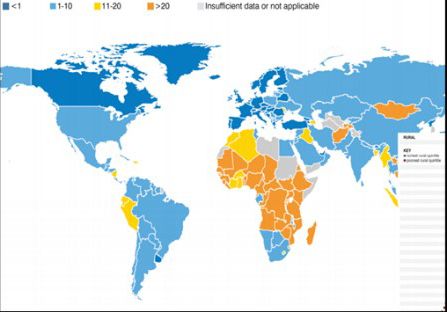
Percentage of population using an unimproved drinking water source
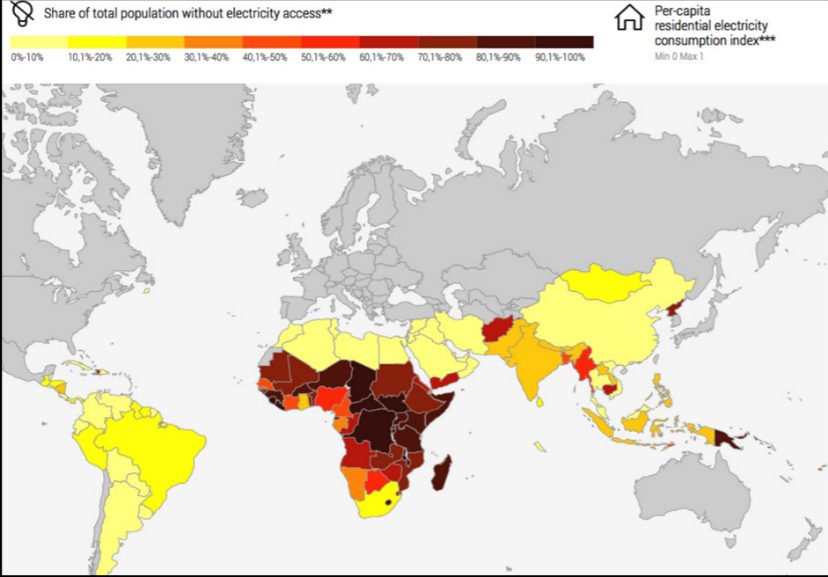
Share of total population without electricity access
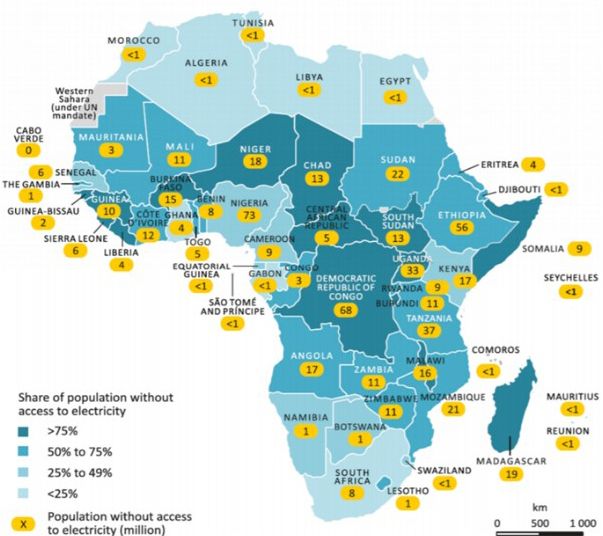
Population without access to electricity in Africa by country, 2016
Figure 1 - Sub-Saharan Africa indexes are at the lower end of world UN statistics
Africa is the Continent with the youngest and most rapidly increasing population demographics, implying remarkable energy demand projections, due to industrial development and rapid urbanization, as well as higher quality of supply service. By 2050, energy demand is forecasted to double against 2015 figures, with electricity and peak power increasing 6-fold (3-folds in per capita values), which will be enabled by 1 TW of RES installed capacity (out of more than 3 TW potential) [2].
The exploitation of large, diversified and mostly clean primary energy resources require substantial and coordinated efforts in evacuating the power via transmission and distribution infrastructure (T&D). It also requires operational capabilities to facilitate the technical operations and trading across boundaries. Africa peculiarly requires heavy investments for increasing the size, outreach, and reliability of its national grid systems, whilst simultaneously also needing investments on the edges of conventional T&D networks: rural microgrids on the one end, while on the other end long interconnections between major African regions and – through submarine cables - towards its potential neighbours in Europe and Middle East. This matches well with the present CIGRE perspective of embracing power systems with an “end-to-end” approach.
Microgrids are receiving worldwide attention with the rationale of optimal exploitation of distributed resources, while limiting the need for grid expansion. In Africa they are important as off-grid or hybrid applications, complementary to the extension of existing grids for isolated communities. The improvements of the performance and cost of distributed generation (particularly photovoltaic, storage and energy management solutions) make these solutions increasingly affordable, and in some instances, they are the only viable option from a techno-economic and environmental perspective (Fig.2). CIGRE has published a specific Technical Brochure (TB) 635 on Microgrids and is finalising a TB from Working Group (WG) C6.38 on rural electrification, where comprehensive descriptions of technologies and operational patterns are provided, together with several case studies as background to such applications.
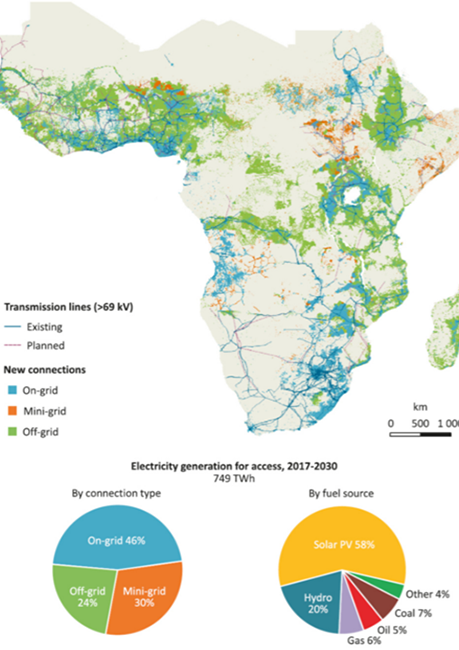
Figure 2 - Microgrids in Africa (source: IRENA)
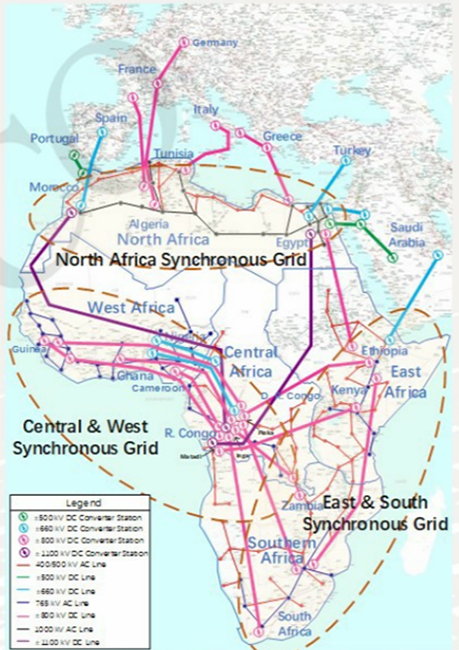
Figure 3 - GEIDCO Vision of future African power grids
On the other end of T&D system, interconnection projects are proliferating, aimed first at linking high potential generation areas with distant load centres; thereafter the RES-based power system requires its scattered resources to be aggregated over a wider geographical footprint, so that complementary patterns, both in generation (hydro basins, river flows seasonality, solar at different longitudes) and in load profiles can be optimised. Present power flows are limited to local supply/demand areas, often with low quality of service and scarce resilience. Future power flows (Fig.3), if developed under a continental optimised scenario, would see Central Africa exporting to the other parts of the Continent, and the intercontinental interconnections used bi-directionally as swing exchanges, thereby following stochastic generation patterns and/or market prices. Three integrated (possibly synchronous) Ultra High Voltage AC grids could be consolidated: North, Western Central, South East, and these could then be interlinked through an overlay of Extra High Voltage DC bulk corridors.
The next step will be to extend the African grids on the Northern and North-Eastern borders.
Cross-Mediterranean links, providing direct access to the ENTSO-E internal market, have already shown their feasibility, and some are nearing a realisation stage (Tunisia-Italy); the overall picture is being assessed and promoted with cooperative mindset by MedTSO (Association of all sea-facing TSOs) in their MasterPlan. The upside vs several previous Mediterranean studies, is to have all the stakeholders joined under a common regional approach, notably the extra-European ones, who in many cases have no electricity market, nor have they unbundled yet; this implies to solve, beyond the ordinary techno-economical hurdles, also those stemming from multi-jurisdiction projects , i.e. investment and governance options, multi-party operation modes and trading arrangements among countries with very different legislative/ regulatory frameworks, financing capabilities and energy strategies.
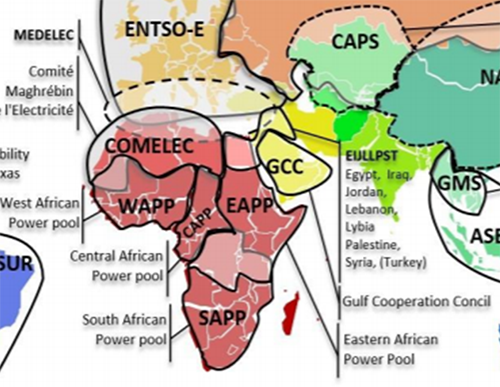
Figure 4 - African Power Pools and neighbouring ones
This is probably the toughest challenge for all major interconnections development within the African system, which is currently associated in 5 regional blocks 8 (Fig. 4). CIGRE is indeed supporting the creation of National Committees in each of these blocks, at regional level where individual membership would be too small; this is in place already in Southern and Western Africa, and underway in Eastern Africa.
Links into the Arabic peninsula (under consideration by Egypt, Saudi Arabia, and others), and beyond to the GCC (Gulf Cooperation Council) and from here to central Asia would represent the access to a future, potential global grid, which feasibility is currently being studied by WG C1.35 (TB 775 published Sept 2019) and C1.44 (on going, see article on Electra N.314 – February 2021); results from preliminary studies show a positive rationale for connecting Africa with Europe and Asia.
The vision of integrating an African continental grid is being addressed in depth also by GEIDCO (Global Energy Interconnection Development and Cooperation Organisation), with a broader scope encompassing the co-development of the power sector together with industry, mining, metallurgy, manufacturing and trade, under an overarching regional or continental umbrella. Funding the capital-intensive infrastructures, beyond the usual grants and loans from international donors, requires modern business models based on flexible long-term purchase contracts and proper risk management mechanisms to attract foreign investors.
Paramount challenge for this vison to be realised will be the political support and multilateral governance, under a continental organisation like the African Union or African Development Bank, who recently released a “Baseline Study” as phase 1 of a continental transmission masterplan with horizon year 2063 [3] ; this recommends for the second phase (implementation) to establish a permanent body for skills transfer and alignment with existing national or sub-regional infrastructure projects. This idea should be coupled with a broader, worldwide guidance to secure a strong investors pool.
The development of a reliable and affordable African integrated power system is considered as a fundamental propaedeutic step towards socio-economic emancipation. The World Bank has a specific focus on Africa and has accordingly signed a cooperation agreement with CIGRE to set up a platform for the transfer of knowledge to unlock the access to electricity in Africa, whilst defining a financial framework for a training programme to impart such knowledge. Consequently, CIGRE has released a catalogue of topics for the dissemination of CIGRE vast and unbiased knowledge-base, through a set of face-to-face sessions, supported by webinars and tutorials. Indeed, one of the founding pillars of CIGRE is to disclose technical information and practical experiences, and to share this with professionals worldwide, who can learn, replicate, or adapt it, to the benefit of their countries, especially those in need to cover a knowledge gap - as it is for Africa. To support the much-needed capacity building initiative in Africa, CIGRE calls for any member who would like to contribute on subjects relevant for the African situation. Proposals can be directed to Konstantin Staschus and Kurt Dedekind, who are leading the Africa WG as an extension of the Technical Council role.
Illustration credit: Banner & thumbnail by Bruchin Noeka on Unsplash - South Africa
